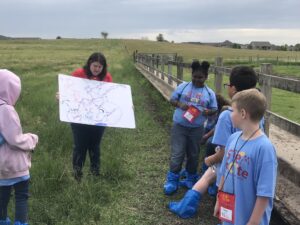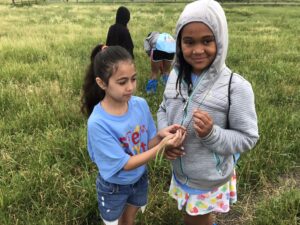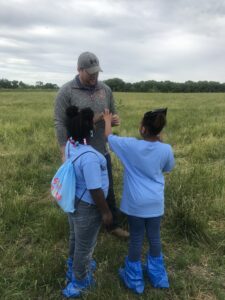Final report for YENC18-125
Project Information
Sustainable pastures increase profit for farmers through increased productivity and profitability. Good pasture maintenance will reduce erosion, protect streams, provide pollinator habitat and promote environmental stewardship. In Iowa where pasture is about 10% of land, farmers can make pasture more sustainable through rotational grazing, planting more diverse and native species, and using natural windbreaks. Through workshops,
youth will learn the basics of pasture maintenance, livestock use, sustainable pasture practices and then apply this learning to self-directed experiments. Youth can improve the quality of life in their communities by creating action plans for how to relay this information to others.
1. Provide youth with skills to maintain pastures through workshops with hands-on activities and interactive presentations on sustainable pasture.
2. Disseminate knowledge of the benefits of sustainable pasture practices for livestock, people, and the environment through a series of workshops.
3. Increase the use of sustainable pasture practices in Iowa as youth develop action plans to bring the information to their communities.
4. Foster positive youth development by giving youth the opportunity to make positive changes in their communities.
5. Generate interest in science careers by taking students through a self-directed experiment on pasture plant diversity.
Cooperators
Educational & Outreach Activities
Participation Summary:
We presented two workshops at three different field days held at the ISU research farms (Sutherland, Nashua and Ames, IA). These field days are for middle and high school students and their teachers and between the three field days, 500 students were reached. The workshops were presented for a total of 30 times. A curriculum was created and all teachers will receive a flash drive with the curriculum along with some printed teaching materials.
Through the activities in this program youth learned how to improve sustainability of pasture by focusing on maintenance of pasture land and livestock with minimum inputs and reduced environmental impact. Specifically, youth should understand that:
- Good pasture management can help Iowans make better use of land and natural resources while meeting nutritional needs of livestock and increasing profit.
- More than one plant species is better for a managed pasture system and plants need time to recover after grazing.
- Rotational grazing increases animal grazing efficiency and allows plant recovery
- Stocking rate, nutrition and diseases all need to be considered for proper animal health
Upon completion of the workshops a survey will be completed by participants to help determine knowledge gain and any practices that the youth would implement as a result of the workshops. The success of the program will be shared as a press release.
Learning Outcomes
The curriculum was used at three large Iowa youth events, STEM InCyte Camp in Ames, Northwest Precision Ag Days in Sutherland and North East Precision Ag Days in Nashua. Over 6 days we did hour long lessons in groups of about 20 youth at a time for a total of 30 hours of teaching time with 500 youth. We provided the curriculum materials to educators at 30 schools in multiple cities across northern Iowa.
When youth were asked to write down one thing they learned from the activities, responses included:
“All the different things in there (in the pasture) and different plants.”
“Cows don’t have top teeth in the front.”
“Different types of weeds.”
“A lot of things need pastures to live.”
“I learned that there are two main types of plants i.e dicots and monocots.”
“Dicots have tap roots.”
“Dicots have two cotyledons.”
Youth also successfully created food webs of organisms that could be found in a pasture.
In post event surveys, many youth responded that they were interested in learning about animal science (75% responded yes or usually) and would like a job that uses science (63% responded yes or sort of).
Many youth responded that they found the activities engaging and interesting (57%) and that they had a better understanding of ag careers after the activities (71%).
35% of youth participants at the Northwest Precision Ag Days responded that they lived on farms. These are youth that would potentially be able to directly apply what they have learned to management of livestock on their family farms. Percent of youth on farms is likely the same or higher for the Northeast Precision Ag days as all the schools that attended are in small towns in rural areas.
Due to time constraints and changes in how the program was executed we were not able to find opportunities to collaborate with private farm owners. However, we did work with Research Farm Managers at three Iowa State University Research Farms to find appropriate teaching materials and spaces for using the curriculum. These were Warren Pierson from the Field Extension Education Laboratory, Shannon Hoyle at Northeast Research Farm, and Terry Tuttle at Northwest Research Farm.



Project Outcomes
Information Products
- Curriculum: Paddocks, Pastures, and People (Course or Curriculum)